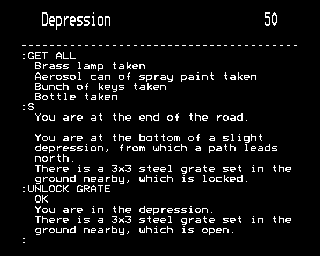Retro Replay Review
Gameplay
Acheton shines as a text-based adventure that challenges players to navigate an intricate network of over 400 interconnected rooms. From the moment you type your first command, you are thrust into a labyrinthine dungeon filled with secret passages, locked doors, and cleverly hidden treasures. The interface, while minimalist by today’s standards, relies on straightforward verb-noun inputs—“take lamp,” “open door,” “examine statue”—which keep the focus squarely on exploration and puzzle-solving rather than flashy mechanics.
(HEY YOU!! We hope you enjoy! We try not to run ads. So basically, this is a very expensive hobby running this site. Please consider joining us for updates, forums, and more. Network w/ us to make some cash or friends while retro gaming, and you can win some free retro games for posting. Okay, carry on 👍)
Item-based puzzles form the heart of Acheton’s gameplay loop. You’ll spend hours meticulously cataloging objects, experimenting with combinations and locations, and retracing your steps when a clue finally clicks. Whether you’re using a rusty key to jam a lock or combining a rope and bucket for an unexpected shortcut, each successful solution rewards you with a satisfying “You have solved the puzzle” moment that feels well-earned. The sheer volume—over 200 distinct items—ensures that no two playthroughs feel identical.
One of Acheton’s standout features is its graded hint system, which strikes a careful balance between frustration and guidance. If you find yourself stuck, you can summon progressive clues that nudge you toward the next logical step without outright revealing the answer. This scalable help function preserves the sense of discovery while preventing beginner players from abandoning the game in exasperation. It’s a thoughtful design choice that other classic adventures rarely implemented.
Movement and mapping in Acheton are both a rite of passage and a subtle puzzle in themselves. With dozens of rooms sporting cryptic descriptions—“A damp corridor,” “A dusty chamber with a broken pillar”—you’ll quickly learn the value of pen and paper (or a simple text document) to chart your progress. As the dungeon grows in complexity, your homemade maps become invaluable tools, transforming what could be a tedious exercise into an engaging cartography challenge.
Graphics
Although Acheton lacks visual graphics in the traditional sense, its evocative text descriptions serve as the game’s artistic canvas. By relying solely on prose, the designers empower your imagination to fill in the atmospheric details. Whether you picture flickering torchlight bouncing off mossy walls or the cold gleam of a hidden gem, the world of Acheton feels remarkably tangible despite its ASCII origins.
The absence of pixel art or animations is hardly a drawback; instead, it becomes part of the game’s charm. The sparse text output emphasizes clarity and consistency, making it easy to visualize your surroundings and the objects you collect. When the game describes “A menacing statue of a dragon, jaws agape,” you’re left with an indelible mental image that remains more vivid than many early graphical adventures.
Sound effects and music are similarly non-existent, but this silence further immerses you in the dungeon’s claustrophobic atmosphere. The only auditory feedback comes from the tapping of your keyboard and the occasional system beep on certain platforms. In this near-monastic audio environment, every text prompt feels weighty, reinforcing the sensation that a single typo could mean the difference between triumph and peril.
For retro enthusiasts, Acheton’s purity is a feature, not a bug. The lack of flashy distractions highlights the game’s core strengths—logical puzzles and storytelling—while providing a glimpse into the pioneering era of interactive fiction. If you’re accustomed to modern, visually-driven titles, you may find Acheton’s text-only presentation refreshingly focused and intellectually stimulating.
Story
Set in a subterranean realm of twisting corridors and hidden treasure chambers, Acheton crafts a compelling narrative through sparse but evocative prose. You assume the role of an intrepid explorer seeking the mythical wealth buried deep beneath ancient stone. The storyline unfolds gradually as you uncover scrolls, decipher runes, and piece together the dungeon’s dark history—bit by bit, room by room.
The game’s world-building is subtle yet effective. Instead of lengthy cutscenes or dialogue trees, Acheton relies on environmental storytelling: a bloodstained dagger here, a crumbling mural there. These fragments combine to create an immersive tapestry, hinting at a forgotten civilization’s rise and fall. There’s a satisfying sense of discovery when you link one clue to another and begin to imagine the greater narrative arc behind the dungeon’s design.
Unlike many contemporaneous adventures that stop at isolated puzzle rooms, Acheton weaves its challenges into a cohesive whole. Every puzzle solved brings you closer to the ultimate objective, and the stakes feel real because the world itself reacts to your progress. Doors swing open, passages shift, and new areas become accessible, reinforcing the storyline’s momentum and keeping you invested in the dungeon’s secrets.
Although the game’s text-driven nature means the story unfolds at your own pace, you’ll find yourself eagerly typing “go north” just to see what comes next. The frequent reveals—whether a hidden passage or a cryptic inscription—provide enough narrative payoff to prevent the experience from feeling like a dry puzzle exercise. Instead, Acheton strikes a satisfying balance between brain-teasing challenges and rich, emergent storytelling.
Overall Experience
Acheton stands as a testament to the power of interactive fiction. Its sprawling dungeon, teeming with over 400 rooms and 200 items, offers hours of exploration for both new players and seasoned text-adventure veterans. The game’s elegant command parser and graded hint system ensure that frustration is tempered by meaningful progress, making it accessible without sacrificing depth.
One of the most rewarding aspects of Acheton is the sense of ownership you gain through manual mapping and note-taking. Far from feeling like a chore, creating your own maps fosters a deeper connection to the world and heightens the thrill of discovery. Every new branch in the maze or hidden alcove feels like a personal triumph, solidifying your bond with the dungeon and its mysteries.
While modern audiences may be more familiar with visually driven RPGs and point-and-click adventures, Acheton’s text-centric design delivers a unique, nostalgia-tinged experience. It harks back to the early days of home computing, where imagination was the primary graphics engine. For players willing to embrace its old-school sensibilities, the game offers a rewarding blend of challenge, atmosphere, and narrative intrigue.
In summary, Acheton remains a compelling entry in the pantheon of classic text adventures. Its substantial scope, thoughtful puzzle design, and immersive storytelling combine to create an experience that is as intellectually stimulating as it is nostalgically appealing. If you’re seeking a deeply engaging dungeon crawl that puts your wits to the test, look no further than Acheton.
 Retro Replay Retro Replay gaming reviews, news, emulation, geek stuff and more!
Retro Replay Retro Replay gaming reviews, news, emulation, geek stuff and more!









Reviews
There are no reviews yet.